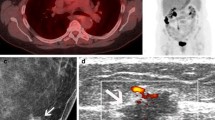Abstract
Positron emission tomography (PET) with 18F-fluorodeoxyglucose (FDG) has been shown to be an effective and accurate diagnostic technique for breast cancer. However, benign breast lesions have also been reported to show a false-positive FDG uptake on PET. We present two cases of benign tumors that revealed FDG uptake on PET and were difficult to distinguish from breast cancer. A 46-year-old premenopausal woman noticed a mass in her right breast. Ultrasonography showed a hypoechoic mass with the size of 7.7 × 3.9 mm and an irregular shape in the right breast. PET demonstrated a focal accumulation of FDG with a maximum standardized uptake value (SUVmax) of 2.1. Excisional biopsy was performed, and ductal adenoma was diagnosed. In the second case, a 36-year-old premenopausal woman was pointed out as showing an abnormality in the left breast on screening mammography. Ultrasonography showed a hypoechoic mass of 1.5 × 1.2 cm in size in the left breast. The lesion was depicted as a mass with prominent enhancement on dynamic CT and a focal accumulation of FDG with SUV max of 3.5 on PET. It was diagnosed as fibroadenoma of mastopathic type histopathologically by excisional biopsy. The readers should be aware that these benign tumors may cause false-positive results on PET.
Similar content being viewed by others
References
Avril N, Dose J, Janicke F, Bense S, Ziegler S, Laubenbacher C, et al. Metabolic characterization of breast tumors with positron emission tomography using F-18 fluorodeoxyglucose. J Clin Oncol 1996;14:1848–1857.
Abouzied MM, Crawford ES, Nabi HA. 18F-FDG imaging: pitfalls and artifacts. J Nucl Med Technol 2005;33:145–55; quiz 162–3.
Heinisch M, Gallowitsch HJ, Mikosch P, Kresnik E, Kumnig G, Gomez I, et al. Comparison of FDG-PET and dynamic contrast-enhanced MRI in the evaluation of suggestive breast lesions. Breast 2003;12:17–22.
Avril N, Rose CA, Schelling M, Dose J, Kuhn W, Bense S, et al. Breast imaging with positron emission tomography and fluorine-18 fluorodeoxyglucose: use and limitations. J Clin Oncol 2000;18:3495–3502.
Palmedo H, Bender H, Grunwald F, Mallmann P, Zamora P, Krebs D, et al. Comparison of fluorine-18 fluorodeoxyglucose positron emission tomography and technetium-99m methoxyisobutylisonitrile scintimammography in the detection of breast tumours. Eur J Nucl Med 1997;24:1138–1145.
Basu S, Nair N, Thorat M, Shet T. Uptake characteristics of FDG in multiple juvenile cellular fibroadenomata of the breast: FDG-PET and histopathologic correlation. Clin Nucl Med 2007;32:203–204.
Azzopardi JG, Salm R. Ductal adenoma of the breast: a lesion which can mimic carcinoma. J Pathol 1984;144:15–23.
Sakamoto G. Essential breast pathology, and the differential diagnosis. I. Mastopathic fibroadenoma (in Japanese). Byori To Rinsho 2001;19:395–397.
Kuroda H, Takeuchi I, Ohnishi K, Sakamoto G, Akiyama F, Toyozumi Y, et al. Clinical and pathologic features of fibroadenoma of the mastopathic type. Surg Today 2006;36:590–595.
Author information
Authors and Affiliations
Corresponding author
About this article
Cite this article
Yamaguchi, R., Futamata, Y., Yoshimura, F. et al. Mastopathic-type fibroadenoma and ductal adenoma of the breast with false-positive fluorodeoxyglucose positron emission tomography. Jap J Radiol 27, 280–284 (2009). https://doi.org/10.1007/s11604-009-0335-2
Received:
Accepted:
Published:
Issue Date:
DOI: https://doi.org/10.1007/s11604-009-0335-2




